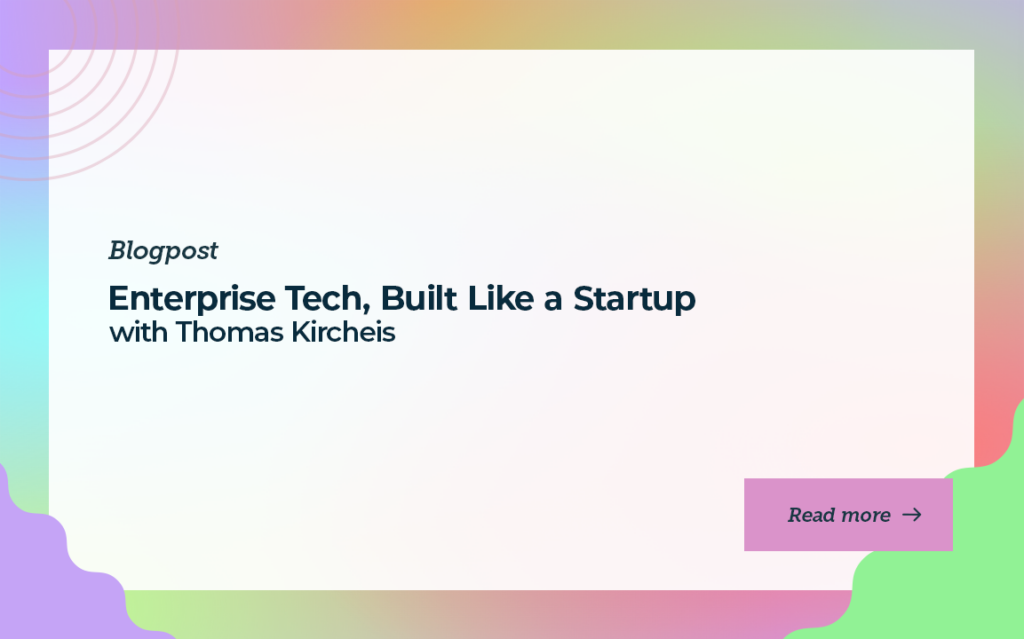Enterprise Tech, Built Like a Startup with Thomas Kircheis

Product-market fit doesn’t always start with innovation. Sometimes, it starts with frustration. That’s exactly how Pulpo WMS began: not as a genius idea in a boardroom, but as a real-world pain point inside a medical warehouse.
A Real Business with a Real Problem
Thomas Kirchheis and his co-founder didn’t set out to build software. They were just trying to fix a glaring inefficiency in a warehouse packed with 20,000+ medical SKUs, many of them with expiration dates and durability requirements.
Despite running a modern ERP system with a million+ customers, there was no solution to actually manage the physical warehouse. Inventory tracking? Sure. But real-time optimization of movements inside the warehouse? Not even close.
“We estimate that over 50% of warehouses in developed countries still run on pen and paper.”
Five Warehouses Per Product
That coffee cup on your desk? It likely passed through five warehouses before reaching you. And three of those were probably managed manually.
Let that sink in: Logistics has scaled globally, but the backbones of fulfillment are still offline.
Naivety Meets Complexity
They thought building a warehouse management system would be a straightforward process. It wasn’t.
- Critical software means it can’t afford to break.
- MVPs aren’t feasible. You’re either all-in or nothing ships.
- Some customers run with half a million SKUs. Speed and accuracy aren’t optional.
“You’d think storing and shipping would be simple. But it’s a live system. Things break, get misplaced, or mis-scanned. And that cascades.”
The PMF Insight
Pulpo didn’t start with a pitch deck. It started with a founder running a business who couldn’t find software that worked. That’s what early product-market fit looks like: solving a painful, overlooked, but critical problem, better than anyone else.
Building for Scale from Day One
Most startups build quickly, acquire users, and then rebuild when things go wrong. Pulpo did the opposite.
When Thomas and his co-founder set out to build a warehouse management system, they didn’t rush to an MVP. They spent six months testing technology, running simulations, and planning for scale before writing real product code.
“If we build it once, we don’t want to rebuild it. Period.”
Why? Because warehouse software isn’t optional infrastructure.
If your WMS fails, your warehouse shuts down. Orders don’t get picked. Products don’t get shipped. People stand around. Costs spike. Customers rage.
This isn’t a nice-to-have tool. It’s a mission-critical system that must work every second of every day, for every client, every SKU, and every scan.
“You can’t build a WMS that works 70% of the time. It’s either reliable, or it’s useless.”
Designing for Complexity, Without Hitting a Ceiling
Most WMS platforms start simple, then get trapped by their own architecture.
- They ignore expiration tracking.
- They assume static warehouses.
- They aren’t built to scale across countries, ERP systems, or millions of SKUs.
Pulpo was different. From day one, the team made design decisions that anticipated the ceiling:
- Used Phoenix Framework (Erlang/Elixir): same backend tech as WhatsApp and Visa.
- Built multi-tenant from the start: no one server per customer nonsense.
- Everything headless, API-first: so integrations are fast and scalable.
“We built with complexity in mind, even if it slowed us down early. Because adding complexity later is usually impossible.”
Why the Robots Aren’t Coming (Yet)
Everyone loves talking about automated warehouses and robot arms. But Pulpo bet on reality, not hype:
- Over 90% of warehouses still operate with humans and forklifts.
- Automated hardware is expensive and slow to deploy.
- Most companies can’t afford five-year ROI timelines. Especially in fast-moving e-commerce.
“Try buying an automated forklift. You’ll wait two years, and maybe it won’t even work.”
Real Validation, Not Vanity
Before they built a line of code, the team hit the phones.
- Every friend. Every founder. Every warehouse owner.
- The verdict? Most were still printing out pick sheets.
- Even $200M+ businesses were running operations on Excel.
The deeper they went, the more it became obvious: the market wasn’t under-automated. It was underserved by bloated, enterprise-first software.
“We got pitched $1M WMS rollouts, full of consultants, delays, and hidden costs. All for something that’s supposed to move a box from A to B.”
Proof in the Margins
They didn’t just make things easier. They made them cheaper.
In their own warehouse, Pulpo reduced staffing needs from 50 people to 20. That’s real ROI, and it’s why the pitch was simple: if this costs $1, you should get $2 back.
When No One Knows Your Category, You Have to Teach Before You Sell
If you’re building something in a category people don’t even know exists, don’t expect them to come searching for it. They won’t.
They’ll search for the pain, not the product. That’s why most early buyers of warehouse software don’t Google “WMS”. They Google “how to track inventory,” or “why can’t I find anything in my warehouse?”
If your buyers don’t know what to call their problem, you have to teach them how to think about it. That’s not a marketing challenge, it’s a product strategy one. Founders in legacy markets don’t just build software. They also build businesses. They build language for the pain.
Don’t Ship an MVP If the System Can’t Fail
When your product becomes part of someone’s operations, not just a dashboard or analytics, but how they ship, failure isn’t an option. You don’t get the luxury of building fast and fixing later.
You must design for complexity upfront, even if it slows you down. Inventory systems. Payments. Anything involving logistics, compliance, or irreversible customer experience. These aren’t MVP-friendly markets.
If your software fails 1% of the time, it’s already unusable.
Switching Costs Are the Real Lock-In. Not Contracts
Early-stage founders worry about churn. But if your product is deeply embedded into your customer’s process. If removing it means re-training teams, re-mapping operations, and disrupting fulfillment, your real retention mechanism is performance, not paperwork.
You don’t need 12-month contracts if your product performs better than anything else. And if it doesn’t, no contract will save you.
Design for reliance, not enforcement.
Educate Before You Sell
Your market’s biggest problem might be a lack of vocabulary. If they’ve never heard of your solution, they can’t buy it.
The fix: Build your inbound marketing around what your customers are already searching for, not what you want them to understand. If they’re Googling “how to fix fulfillment delays”. And your blog is about “streamlining mid-tier WMS stack integration”. You’ve already lost them.
Reverse-engineer content from the search terms that signal pain. Then lead them toward the solution.
Outbound Only Works When You Know Exactly Where You Win
Founders often jump into outbound too early. But unless you know exactly where your product outperforms the status quo, you’re just interrupting people with noise.
Effective outbound is specific. You don’t sell “a better tool.” You sell:
- Faster expiration tracking.
- Real-time scanning feedback.
- One-click Shopify sync.
- Full visibility on a million SKUs.
Until you know those edges and who actually feels the pain, outbound should be a scalpel, not a shotgun.
Why Outbound Fails Early
Most early-stage founders treat outbound like a shortcut. Send enough emails, find some buyers, close some deals. But the reality, especially in complex sales, is that outbound only works if three things are true:
- You know exactly who your buyers are.
- You can reach them reliably.
- You have something specific and urgent to say.
If any of those break, so does the channel.
Outbound Requires Precision. Not Volume
If your sale involves multiple stakeholders, legacy systems, and low category awareness, going wide is not the solution. The real game is targeting. Knowing not only who to target, but also why now, and being able to articulate that in a sentence.
Outbound needs to answer three things instantly:
- Why this company?
- Why this person?
- Why now?
If your targeting doesn’t deliver those answers, no amount of clever messaging will fix the conversion rate.
Awareness and Timing Make or Break the Funnel
Outbound doesn’t just hit ready buyers, it hits everyone. That means you’re often catching people before the pain spikes. They don’t know they need your product, yet.
That’s why nurturing matters. One bad quarter, one failed holiday rush, one internal escalation, and suddenly the buyer is ready to talk. But they won’t remember you if you only reached out once.
Outbound is not a lead-gen sprint. It’s a pipeline pressure system. You’re laying the groundwork for deals that might close in six months, not six days.
Most Founders Underinvest in Time, Overinvest in Tools
Outsourcing outbound might look tempting. Pay $5K/month, generate meetings, done. But no outsourced team will care about timing, targeting, or follow-up the way you will. And most founders expect a return on investment (ROI) far too soon.
If you hire an SDR in-house, you would give them 9–12 months to ramp up. But most people give an outsourced team six months before pulling the plug, even though the math is the same.
Outbound works, but only with patience and effective systems. It compounds, not spikes.
CAC Efficiency > Volume at Early Stage
If you’re bootstrapped or operating lean, one of the best growth levers is not marketing spend, it’s efficiency. Knowing how much time and money it takes to acquire a dollar of ARR is the only way to scale with control.
If you’re closing customers at $2+ of ARR for every $1 spent, and you’re doing it with under three hours of active sales time, that’s not just efficient. That’s foundational.
Most early-stage companies don’t measure this. The ones that do grow on their own terms.
Signs of Product-Market Fit Aren’t Loud. But They’re Clear
If you’re listening closely, product-market fit doesn’t hit like a drumroll. It creeps in. You start hearing the same objections disappear. The same buyer types show up. The second call isn’t about “what does it do”. It’s about pricing and setup.
That’s the moment to pay attention. When you can predict the conversation before it happens, it’s not just product-market fit, it’s go-to-market fit.
In Pulpo’s case, it was the mid-sized Shopify merchants with ShipStation on the backend. Same pain. Same stack. Same urgency.
Find your repeatable customer, and double down.
Don’t Just Qualify Deals. Diagnose the Moment
When a customer reaches out, the most valuable question isn’t “what do you need?” It’s why now?
The pain existed years ago. Why are they acting today? That question reveals urgency, budget, readiness, and often how high the stakes are internally.
Founders who listen for timing, not just fit, close better deals faster.
A Good Product Doesn’t Just Scale Businesses. It Retains People
A warehouse worker walking 10 miles a day becomes someone who walks two miles a day. That’s less fatigue, fewer mistakes, lower churn. It’s not just operational efficiency. It’s human impact.
Good software reduces friction not just in the system, but in the culture. Workers don’t quit because they’re exhausted. They stay because the job is sane, the tools work, and they don’t get blamed for things that aren’t their fault.
Founders who build in complex industries often overlook this: efficiency is a talent retention strategy.
Self-Service Is the Next Level of Product Maturity
If you can sell and onboard a customer without needing sales or implementation support, you’re not just productized, you’re scalable.
Self-service isn’t just a UX upgrade. It’s a market unlock. It means your customer can solve their own problem. And you can focus on the next 10,000 just like them.
For complex products, self-service is the final frontier. It’s not about removing human touch, it’s about removing friction where the buyer doesn’t want help, just progress.
You’re Not Selling Software. You’re Reducing Returns
The best positioning isn’t about features. It’s about outcomes. In this case, there are fewer returns, fewer errors, and fewer complaints. The customer doesn’t care about warehouse optimization algorithms. They care that the right thing gets to the right person, every time.
Software is easy to sell when the output is measurable, painful, and clearly tied to growth or cost reduction. Founders who anchor their messaging in real-world outcomes close deals faster and experience lower churn rates.
Conclusion
Product-market fit doesn’t announce itself. It shows up in patterns. The same types of customers. The same pain. The same urgency. The second call is about pricing, not “what does it do?”
If that’s happening, your job isn’t to chase more ideas. It’s to build a repeatable system around what’s already working.
For founders in complex or overlooked markets, here’s the playbook:
- Build for reliability, not speed.
- Sell outcomes, not features.
- Target precisely. Nurture patiently.
- Teach the problem before you pitch the product.
Once you’ve found the pain and proven you solve it, the market doesn’t need convincing. It just needs access.
Running a warehouse on spreadsheets or paper? Pulpo WMS helps e-commerce and fulfillment teams get control fast, without bloated setups or costly mistakes.
Subscribe to the Predictable Revenue YouTube channel and get practical, founder-focused sales insights every week. Or join our newsletter and get the best takeaways straight to your inbox.
NO TIME TO READ?


